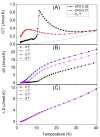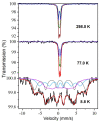Unveiling the Hidden Entropy in ZnFe2O4
- PMID: 35161142
- PMCID: PMC8840487
- DOI: 10.3390/ma15031198
Unveiling the Hidden Entropy in ZnFe2O4
Abstract
The antiferromagnetic (AFM) transition of the normal ZnFe2O4 has been intensively investigated with results showing a lack of long-range order, spin frustrations, and a "hidden" entropy in the calorimetric properties for inversion degrees δ ≈ 0 or δ = 0. As δ drastically impacts the magnetic properties, it is logical to question how a δ value slightly different from zero can affect the magnetic properties. In this work, (Zn1-δFeδ)[ZnδFe2-δ]O4 with δ = 0.05 and δ = 0.27 have been investigated with calorimetry at different applied fields. It is shown that a δ value as small as 0.05 may affect 40% of the unit cells, which become locally ferrimagnetic (FiM) and coexists with AFM and spin disordered regions. The spin disorder disappears under an applied field of 1 T. Mossbauer spectroscopy confirms the presence of a volume fraction with a low hyperfine field that can be ascribed to these spin disordered regions. The volume fractions of the three magnetic phases estimated from entropy and hyperfine measurements are roughly coincident and correspond to approximately 1/3 for each of them. The "hidden" entropy is the zero point entropy different from 0. Consequently, the so-called "hidden" entropy can be ascribed to the frustrations of the spins at the interphase between the AFM-FiM phases due to having δ ≈ 0 instead of ideal δ = 0.
Keywords: calorimetry; hidden entropy; neutron diffraction; spin disorder; zinc ferrite.
Conflict of interest statement
The authors declare no conflict of interest. The funders had no role in the design of the study; in the collection, analyses, or interpretation of data; in the writing of the manuscript, or in the decision to publish the results.
Figures









References
-
- Dolcet P., Kirchberg K., Antonello A., Suchomski C., Marschall R., Diodati S., Munoz-Espi R., Landfester K., Gross S. Exploring wet chemistry approaches to ZnFe2O4 spinel ferrite nanoparticles with different inversion degrees: A comparative study. Inorg. Chem. Front. 2019;6:1527–1534. doi: 10.1039/C9QI00241C. - DOI
-
- Sai R., Arackal S., Kahmei R.D.R., Bhat N., Yamaguchi M., Shivashankar S.A. Crystallographic inversion-mediated superparamagnetic relaxation in Zn-ferrite nanocrystals. AIP Adv. 2020;10:4. doi: 10.1063/1.5130483. - DOI
-
- Cobos M.A., de la Presa P., Llorente I., Alonso J.M., Garcia-Escorial A., Marin P., Hernando A., Jimenez J.A. Magnetic Phase Diagram of Nanostructured Zinc Ferrite as a Function of Inversion Degree delta. J. Phys. Chem. C. 2019;123:17472–17482. doi: 10.1021/acs.jpcc.9b02180. - DOI
-
- Yafet Y., Kittel C. Antiferromagnetic Arrangements in Ferrites. Phys. Rev. 1952;87:290–294. doi: 10.1103/PhysRev.87.290. - DOI
Grants and funding
LinkOut - more resources
Full Text Sources
Research Materials
Miscellaneous

